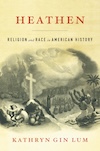Welcome to “Phoning It In,” a gameshow I made up because I am tired and busy but also like to learn about new books! (I am, in fact, so busy that we have not played this game in two years. Welcome back?)

Heathen: Religion and Race in American History
Kathryn Gin Lum
Harvard U. Press
Paperback: Oct, 2024
The point of this exercise (aside from letting me chat with smart folks about cool-sounding projects) is for the author to help me, and by extension you, understand the most important parts of their work without getting bogged down in the particulars.
The particulars matter! If you have the time and the funds and the energy, you should read this book closely, as I know enough about the author to trust that their work is insightful and engaging even if I definitely didn’t give it the attention it deserved! But look, it’s been a long pandemic, okay? Let’s start with the essentials and worry about the rest later.
Today’s contestant is Dr. Kathryn Gin Lum, Professor of Religious Studies and History at Stanford University and author of Heathen: Religion and Race in American History, now available in paperback. Dr. Gin Lum has written for RD about the role of Hell in shaping the US and how Donald Trump’s “shithole countries” epithet is just a crueler way of saying “heathen.” You can read the introduction of Heathen for free courtesy of Harvard University Press.
This interview has been edited for length and clarity.
Challenge 1: Can I correctly identify the argument after skimming the introduction.
MPG: Okay, the quick glance I gave this book tells me that I immediately want and need to read the rest, but rules are rules. Based on my very poor reading of the prologue and introduction, you’re arguing for the continued consequence of the concept of “heathen,” which matters specifically toward a project of identifying and dismantling a White American Christian superiority complex. Did I get it?
KGL: Right! The book is about the continued significance of the concept of “the heathen” to racial governance, to understanding race in America. Race was a heathen inheritance.
MPG: [awards self one (1) gold star for still having “it,” whatever it is; awards KGL additional star for having a baller argument and also a kickass book title, which KGL says she owes to Shahzad Bashir, Sylvester Johnson, and Angela Tarango, who are also awarded gold stars in absentia.]
Challenge 2: Can I—an eager but perhaps, uh, overcommitted and therefore slightly distracted reader—understand key concepts in the book without looking at the book.
MPG: There’s so much going on in this book, but let’s stick to the big one. Hey, what’s a heathen? Who’s a heathen?
KGL: The heathen is complicated! The figure of the heathen arises out of the figure of the pagan, who was originally understood to be those people who failed to embrace Christianity in the ancient Roman context. They lived in the countryside and they clung to their old gods. The heathen is then an Anglo-Germanic translation—the people who live in the heath, the people who are wandering in the wilderness, who cling to Thor and Odin and the old European gods.
MPG: [mumbles something inaudible about her dating history]
KGL: [offers sympathetic courtesy laugh before continuing to unpack this important and dense theoretical apparatus] “Heathen” then spreads to encompass the vast majority of people in the world who are not members of Abrahamic religions. This category divides the globe into four parts: Christians, Jews, Muslims, and heathen/pagan. By the 19th century, Europeans and EuroAmericans realized that these individual non-Abrahamic traditions have names, but—as I argue—these traditions continue to get clumped together under the umbrella of heathen.
MPG: So heathen refers to not-White not-Christians who are also not-Jews and not-Muslims.
KGL: Yes!
MPG: You also use this phrase, “the hierarchy of heathenisms.”
KGL: Yes, I borrow that from Emily Conroy-Krutz.
MPG: And hierarchy is a really important component to understanding the ways “heathen” works, right? We’re not talking about a benign taxonomy here.
KGL: Hannah Adams and other early historians of religion use it as a mostly neutral descriptor, but over the course of the 19th century “heathen” increasingly does racializing work. So as I argue in the book, heathen is never just a religious descriptor. It is a term that takes on and informs racial othering in this country.
A big part of being categorized as heathen is being told you don’t understand your own story, that you don’t have a history, so you need Europeans and EuroAmericans to tell you about yourselves. The heathen story is one of stagnation (if not degeneration), misuse of the land, and misunderstanding of bodies.
We see this in Chinese exclusion as well as in the annexation of the Philippines and the Kingdom of Hawaii. Even though the christianization of Hawaii began much earlier than attempts to annex the territory, we see arguments about Hawaiians being heathen bolstering claims that Hawaiians are not fit to govern themselves. Any violence done to heathens gets understood as what Jon Pahl calls “blessing brutalities,” harm done allegedly for the heathen’s own good.
MPG: So we have a kind of ladder of religio-racial markers with White Christian European and folks of European descent at the top.
KGL: Heathen wasn’t always a space of undifferentiated otherness; Emily Conroy-Krutz’s Christian Imperialism shows that missionaries and colonizers observed civilizational hierarchies within the “heathen world.” At the same time, the category of heathen collapses those hierarchies, putting everyone who’s given that label under this blanket of degradation. “Heathen” actually ends up being a useful way for EuroAmericans to sweep certain people off that ladder—people who make their own civilizational claims that challenge narratives of EuroAmerican superiority or threaten White America’s sense of itself.
[Nobody gets any stars in a section about “blessed brutalities;” MPG is still sitting uncomfortably with the “blanket of degradation” and the smallpox of it all]
Challenge 3: A critique of the book that has absolutely nothing to do with the substance of the book.
MPG: My critique of your book that has nothing to do with the content of your book is about capitalization and your introductory note about your decision to capitalize White.¹ Why was it important for you to capitalize White in this project?
KGL: It’s to mark Whiteness as a racial category. So often Whiteness is the unseen, unraced norm against which all other people are raced. I am, of course, very aware of the politics of capitalization and the fact that the far-right capitalizes White for very different reasons than I do. But so much of this book is about the religio-racial category of Whiteness as formed against the heathen. Capitalizing White is an important way to call attention to Whiteness as a constructed racial category, which is a central project of the book.
MPG: I was really struck by this decision, because my instinct is always to capitalize Black, Brown, or Native while leaving White lowercase—honestly, I feel Whiteness/we White people has/have been uppercased enough? But I wonder, too, if this isn’t a space to think about authors as fully embodied people. I think it does something different for you as an Asian American woman to capitalize White and insist that we think about it as a constructed category, while I feel in my body, a deep, visceral discomfort with capitalizing White, even as I am very invested in the project of trying to denaturalize Whiteness as a racial category.
KGL: Right. It feels jarring! And I want it to be! Not in the way of White supremacists wanting to capitalize White, of course. But it does call attention to the discomfort we should feel around the category.
Challenge 4: In which I try to deflect attention from not having read the book by asking a question I think makes me sound clever.
MPG: A favorite trick of mine when I’m trying to sound smart but I haven’t done my homework is to relate the thing we’re supposed to be talking about to a thing I did read. Heathen argues that we should understand Whiteness as a religio-racial category, which of course made me think of Judith Weisenfeld’s brilliant New World A-Coming. How does your concept of heathen build on Weisenfeld’s theory of religio-racial identity?²
KGL: You mean footnote 32?
MPG: [briefly feels latent Catholic shame at getting pwned so thoroughly even though she has already confessed to not reading the book, keeps on trucking]
KGL: Her work has been so formative in shaping my own—and I also want to put it in the context of the work of Sylvester Johnson, Geraldine Heng, and María Elena Martínez. They’re all arguing for a concept of race that isn’t just phenotypical, not just rooted in the body. They show us how religion creates race. For Sylvester, race is a colonial system of governance that sets the world into the binary of the European colonizer and the non-European colonized. In my book, the category of heathen helps create this binary.
Race is often glossed as social constructions based on bodily characteristics understood as innate or unchangeable. Some scholars contend that heathen isn’t a raced category because you can convert out of heathenism.
MPG: Can you though?
KGL: Well, that’s exactly the issue. The changeable characteristic of the heathen makes it useful in creating the binary of the European colonizer and the non-European colonized—the mutability of the heathen serves as justification for the European to come in and say, we are going to change you. We’re going to change your bodies. We’re going to change your lands. We’re going to give you history. This mindset underlies their project of race making, of racial governance.
Religio-raciality helps us see race as a colonial project of governance. Whiteness isn’t just about skin color—Whiteness is about colonial governance. It’s about those people who claim the ability to go in and change other people’s lives, lands, etc. Whiteness is a religio-racial category. You cannot understand Whiteness without attending to this religious imperative to save the world.
MPG: [awards KGL several many gold stars for having the footnote number memorized and also giving me so many cool authors to go read after this interview.]
Question 5: In conclusion, I did not read the conclusion.
MPG: Your conclusion, which I did not read, is called “The More Things Change.” I know you historians love to “well, actually…” the present. This title suggests to me that some things about the way race and religion work in tandem have, perhaps, stayed the same in important ways.
KGL: Yes! That is exactly the methodological point. Heathens are seen to be history-less; the assumption is that they don’t change over time, whereas Whiteness as a religio-racial category is characterized by its ability to go into the world and change it, to make things change. I’ve long chafed against the disciplinary assumption of history as only ever about change over time. The postscript is my way of saying “Yes, things change. But also? They don’t.” The book as a whole is my attempt to write a history that both attends to change but is also aware of continuity and repetition—and uses that lens of continuity and repetition for White American Christians.
The postscript is about COVID, and the fact that while the word “heathen” might no longer be in popular use, the concepts underlying it are still very present.
MPG: [immediately awards KGL one million gold stars for having written literally anything in the spring of 2020]
KGL: I was trying to process all the anti-Asian hate that was pulling on some really old racist tropes, and also the expectation that America was supposed to be somehow above or removed from a global pandemic. The idea of the heathen world was absolutely at play here—the idea that disease is (or should be) relegated to “backwards” or “undeveloped” places, places racialized as not-White, not-Christian, not-American.
Final Score: Everybody wins when we learn more about religion! Congrats, y’all.
¹ n.b. The style guide for Public Research Associates, Religion Dispatches’ parent organization, also capitalizes White. As per the guide: “We capitalize ‘White people’ because it describes a socially constructed ethnic group not a skin color; just as ‘Black people’ and ‘Brown people’ describe a socially-constructed ethnic group not a skin color.”
² In New World A-Coming, Weisenfeld uses “religio-racial movements” to denote the ways minoritized communities during the Great Migration constructed collective identities through resignification of both their Blackness and their religious commitments. It is a gross oversimplification to reduce Weisenfeld’s theoretical insights to the observation that race and religion are co-constitutive, but that’s a start. Check out Weisenfeld’s conversation with Eddie Glaude on the AAS21 Podcast for more info.





